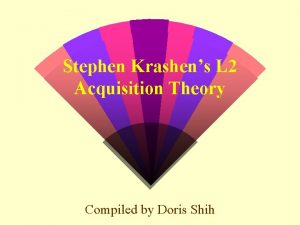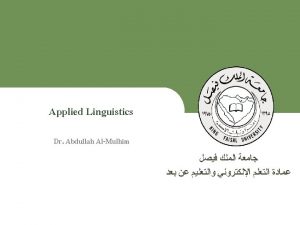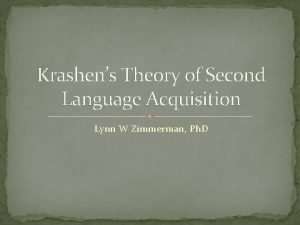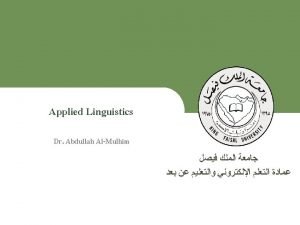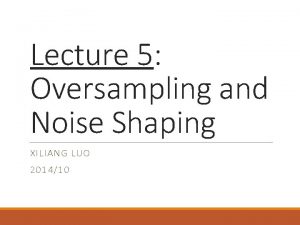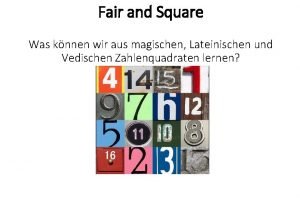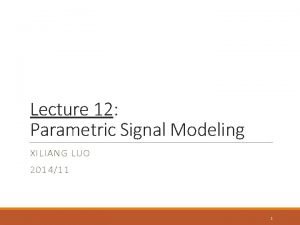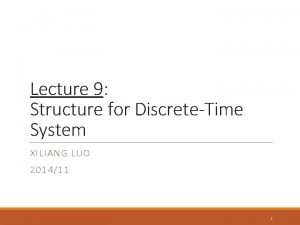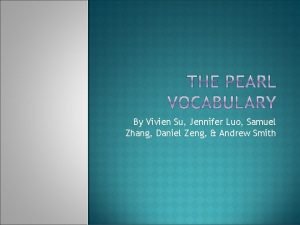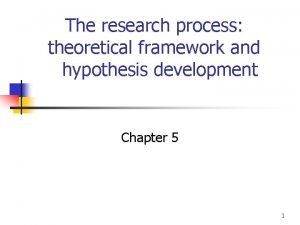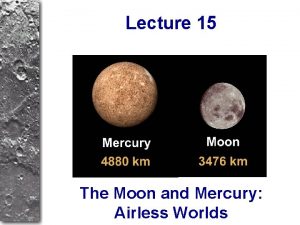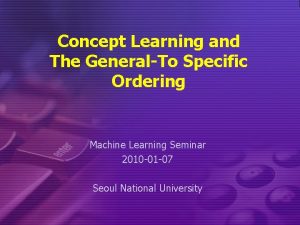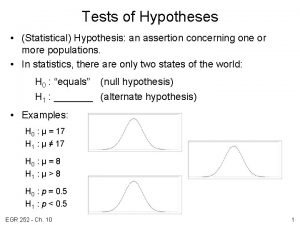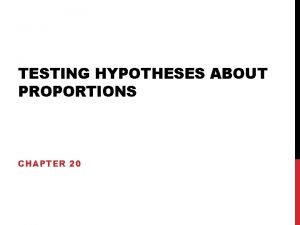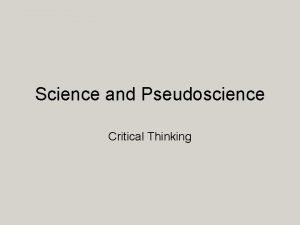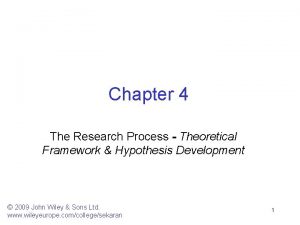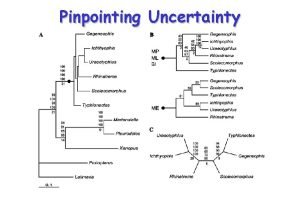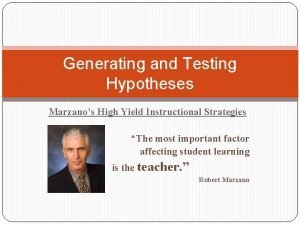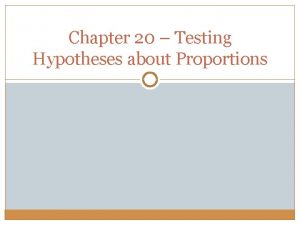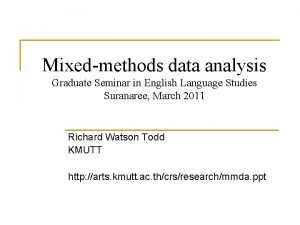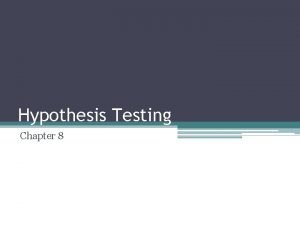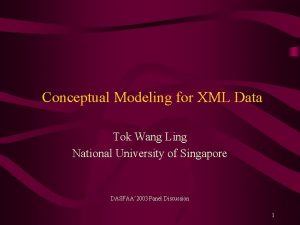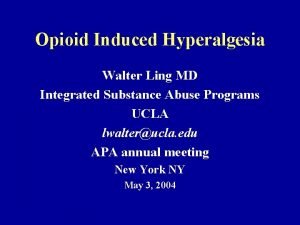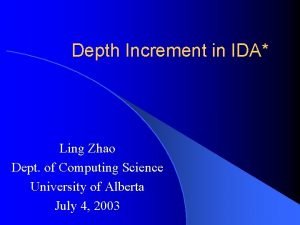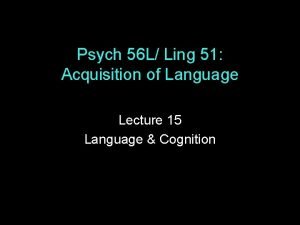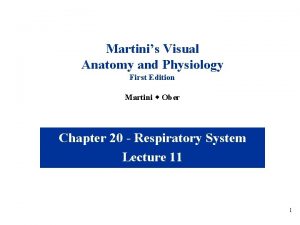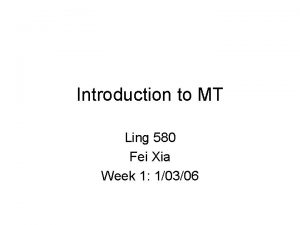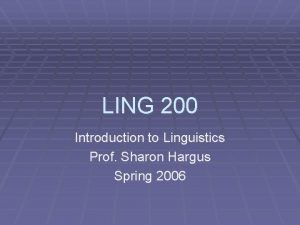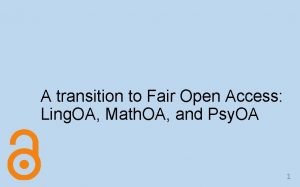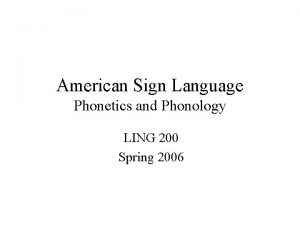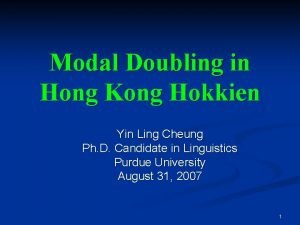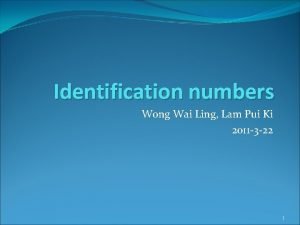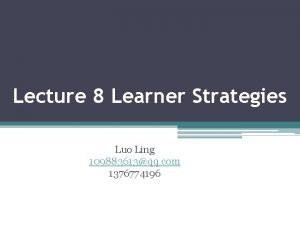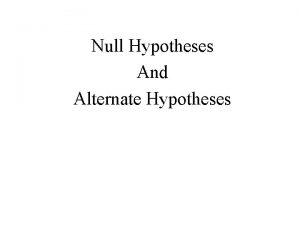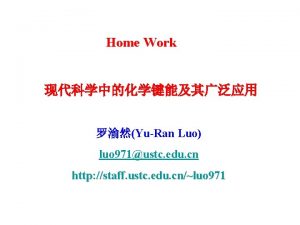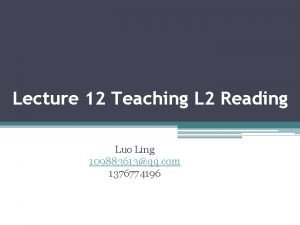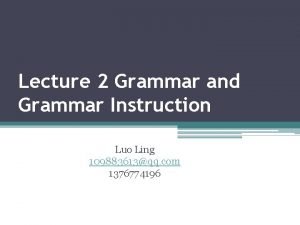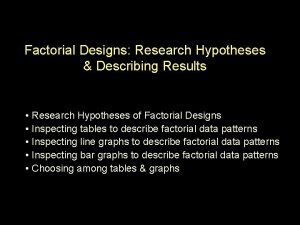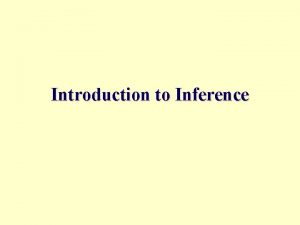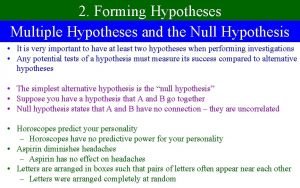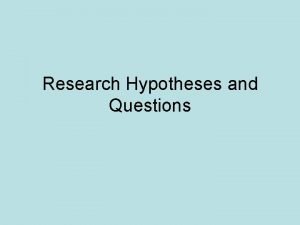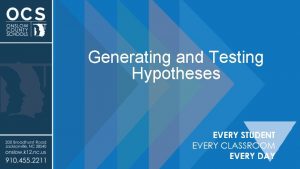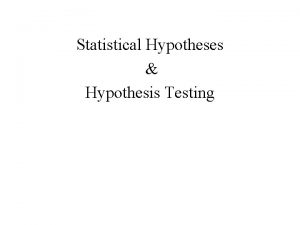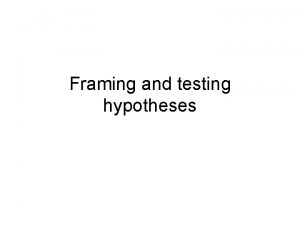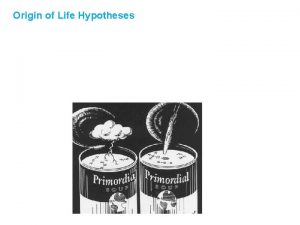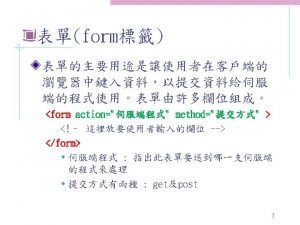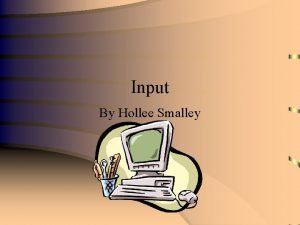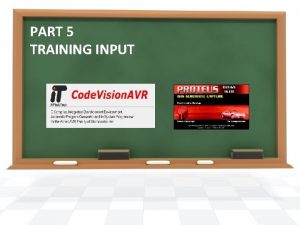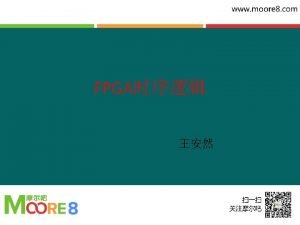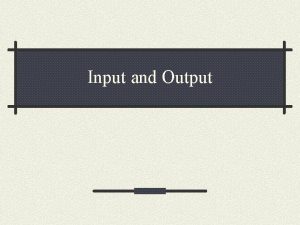Topic 2 Krashens Input Hypotheses Luo Ling 109883613qq



















































- Slides: 51

Topic 2 Krashen's Input Hypotheses Luo Ling 109883613@qq. com 1376774196

Outline 1. 2. 3. 4. 5. The The The Acquisition/ Learning Hypothesis natural order hypothesis Monitor Hypothesis Input Hypothesis Affective Filter Hypothesis

1. The Acquisition/ Learning Hypothesis • The acquisition-learning distinction is perhaps the most fundamental of all his hypotheses. • It states that adults have two distinct and independent ways of developing competence in a second language. • Q 1: Why it is the most fundamental ?

• Language acquisition is a process similar, if not identical, to the way children develop ability in their first language. • Q 2: If this is the case, what implication can we draw? • Attach more importance to acquisition. But why and how?

• Language acquisition is a subconscious process, in the sense that … • language acquirers are not usually aware of the fact that they are acquiring language, but are only aware of the fact that they are using the language for communication.

• The result of language acquisition, acquired competence (in Chomsky’s term), is also subconscious. • Q 3: What is your competence of the Chinese language?

• We are generally not consciously aware of the rules of the languages we have acquired. Instead, we have a "feel" for correctness. Grammatical sentences "sound" right, or "feel" right, and errors feel wrong, even if we do not consciously know what rule was violated. • In non-technical language, acquisition is "picking-up" a language.

• Language learning refers to conscious knowledge of a second language, knowing the rules, being aware of them, and being able to talk about them. • In non-technical terms, learning is "knowing about" a language, known to most people as "grammar rules".

• Some have assumed that children acquire, while adults can only learn. What do you think? • The acquisition-learning hypothesis claims, however, that adults also acquire, that the ability to "pick-up" languages does not disappear at puberty.

• Of course, this does not mean that adults will always be able to achieve native-like levels in a second language. In fact, quite on the contrary. • Q 4: Why most of adults fail to achieve full competence in an L 2?

2. The natural order hypothesis • 'we acquire the rules of language in a predictable order‘ • The natural order refers to the fact that acquisition of grammatical structures proceeds in a predictable order.

• Acquirers of a given language tend to acquire certain grammatical structures early, and others later. • The agreement among individual acquirers is not always 100%, but there are clear, statistically significant similarities.

The morphone studies • English as a first language • The progressive marker ing (as in "He is playing baseball". ) and the plural marker /s/ ("two dogs") were among the first morphemes acquired, while third person singular marker /s/ (as in "He lives in New York") and the possessive /s/ ("John's hat") were typically acquired much later, coming anywhere from six months to one year later.

• For those morphemes studied, the difficulty order was similar to the acquisition order.

The morphone studies • English as a second language • Children acquiring English as a second language also show a "natural order" for grammatical morphemes, regardless of their first language. • The child second language order of acquisition was different from the first language order, but different groups of second language acquirers showed striking similarities.

• There is a natural order for adult learners, an order quite similar to that seen in child second language acquisition.

"Average" order of acquisition of grammatical morphemes for English as a second language

3. The Monitor Hypothesis • 'conscious learning. . . can only be used as a Monitor or an editor‘ • While the acquisition-learning distinction claims that two separate processes coexist in the adult, it does not state how they are used in second language performance.

• Acquisition and learning are used in very specific ways. • Normally, acquisition "initiates" our utterances in a second language and is responsible for our fluency. Learning has only one function, and that is as a Monitor, or Editor.

• Learning comes into play only to make changes in the form of our utterance, after is has been "produced" by the acquired system. This can happen before we speak or write, or after (selfcorrection). • Consider our own productive experiences.

Acquisition and learning in second langauge production Q 5: How to interpret the chart below?

• The Monitor hypothesis implies that formal rules, or conscious learning, play only a limited role in second language performance. • Q 6: What can we learn from this?

• Second language performers can use conscious rules only when three conditions are met. • These conditions are necessary and not sufficient, that is, a performer may not fully utilize his conscious grammar even when all three conditions are met.

• (i) Time • In order to think about and use conscious rules effectively, a second language performer needs to have sufficient time. • Q 7: Do we have enough time? And what will be the consequence if not?

• For most people, normal conversation does not allow enough time to think about and use rules. The over-use of rules in conversation can lead to trouble, i. e. a hesitant style of talking and inattention to what the conversational partner is saying.

• (ii) Focus on form • To use the Monitor effectively, time is not enough. The performer must also be focussed on form, or thinking about correctness. Even when we have time, we may be so involved in what we are saying that we do not attend to how we are saying it.

• (iii) Know the rule • This is a very formidable requirement. Linguistics has taught us that the structure of language is extremely complex. Consider: • Tom told Mary that Sue didn’t listen to him, and she didn’t believe him. • Tom told Mary that Sue didn’t listen to him, but she didn’t believe him.

• And they claim to have described only a fragment of the best known languages. Our students are exposed only to a small part of it. • Even the best students do not learn every rule they are exposed to.

Different monitor users 1. Monitor under-users –not learned or just feel for correctness. 2. Monitor over-users –monitoring all the time 3. Monitor optimal users –use the monitor when appropriate and when it does not interfere with communication

4. The Input Hypothesis • 'humans acquire language in only one way - by understanding messages or by receiving "comprehensible input" --Krashen

• The input hypothesis attempts to answer what is perhaps the most important question in our field—how we acquire language, and gives an answer that has a potential impact on all areas of language teaching. • Q 8: Why and in what way?

• If the Monitor hypothesis is correct, that acquisition is central and learning more peripheral, the goal of our pedagogy should be to encourage acquisition. The question of how we acquire then becomes crucial. • Q 9: How to encourage acquisition?

The question restated • Given the correctness of the natural order hypothesis, how do we move from one stage to another? • If an acquirer is at "stage 4", how can he progress to "stage 5"? • More generally, how do we move from stage i, where i represents current competence, to i + 1, the next level?

The input hypothesis • A necessary必要 (but not sufficient不充分) condition to move from stage i to stage i + 1 is that the acquirer understand input that contains i + 1, where "understand" means that the acquirer is focussed on the meaning and not the form of the message.

• We acquire only when we understand language that contains structure that is a “little beyond” where we are now. --Krashen • the step-by-step principle • Q 10: But how is it possible?

• Linguistic competence alone is not enough! • We use more than our linguistic competence to help us understand. We also use context, our knowledge of the world, our extra-linguistic information to help us understand language. • Congratulations!

The basic requirement • “Humans acquire language in only one way — by understanding messages or by receiving ‘comprehensible input’ ” –Krashen • Input (Exposure to language use ) leads to acquisition—understanding meaning, recognizing L 2 patterns.

The optimal state • “We cannot teach our students; we can only facilitate their learning. ” -S. P. Corder • Affective filter tells us acquisition simply doesn’t take place if the learner is not in the right state, and teaching becomes a hopeless business, a sheer waste of time.

The shortcut • Comprehensible input (i+1) indicates that the “shortcut” should be a step-by-step process. • “The best methods are therefore those that supply 'comprehensible input' in low anxiety situations, containing messages that students really want to hear. …” –S. Krashen

Pedagogical implication • The input hypothesis runs counter to our usual pedagogical approach in second and foreign language teaching!! • Our assumption has been that we first learn structures, then practice using them in communication, and this is how fluency develops. (the 3 -P model)

• The input hypothesis says the opposite. It says we acquire by "going for meaning" first, and as a result, we acquire structure! • The ideas behind CLT and TBLT

Points of the Input Hypothesis • 1. The Input hypothesis relates to acquisition, not learning. • 2. We acquire by understanding language that contains structure a bit beyond our current level of competence ( i+1 ). This is done with the help of context and extra-linguistic information.

• 3. When communication is successful, when the input is understood and there is enough of it, i+1 will be provided automatically. So the best input should not even attempt to deliberately aim at i + 1. • 4. Production ability emerges. It is not taught directly. • Q 11: Comment on “Practice makes perfect. ”

5. The Affective Filter Hypothesis 情感过滤器假说 • 'a mental block, caused by affective factors. . . that prevents input from reaching the language acquisition device'. • how affective variables relate to the process of second language acquisition.

Affection refers to 1. Motivation学�� 机: Performers with high motivation generally do better in L 2 acquisition. 2. Self-confidence自信: Performers with self-confidence and a good self-image tend to do better in L 2 acquisition. 3. Anxiety学� 焦� : Low anxiety appears to be conducive to L 2 acquisition.

affective filter input LAD Acquired competen ce Black Box Operation of the “Affective Filter”

Explanation • Those who are not opt for language acquisition will not only tend to seek less input, but they will also have a high or strong Affective Filter--even if they understand the message, the input will not reach that part of LAD. • Q 12: Think of an example to illustrate this.

Explanation • Those with attitude more conducive to L 2 acquisition will not only seek and obtain more input, they will also have a lower or weaker filter. They will be more open to the input, and it will strike “deeper”. • Classrooms that encourage low filter are those that promote low anxiety among students, that keeps students

Significance • Our pedagogical goal should not only include supplying comprehensible input, but also creating a situation that encourages a low filter. • So, an effective language teacher is someone who can provide input and help make it comprehensible in a low anxiety situation.


Thank you!
 The acquisition learning hypothesis
The acquisition learning hypothesis Krashens monitor model
Krashens monitor model Language
Language Krashens monitor model
Krashens monitor model Sevoflurane
Sevoflurane Xiliang luo
Xiliang luo Das magische quadrat 406
Das magische quadrat 406 Oheishuoltajuus oikeudet
Oheishuoltajuus oikeudet Lynn luo
Lynn luo Qiong luo
Qiong luo Brat
Brat Nnvdia
Nnvdia Xiliang luo
Xiliang luo Xiliang luo
Xiliang luo Entranced antonym
Entranced antonym Hypotheses development
Hypotheses development Hypotheses
Hypotheses Theoretical framework hypothesis
Theoretical framework hypothesis Explain general to specific ordering of hypothesis
Explain general to specific ordering of hypothesis Hypothesis format
Hypothesis format Hypothesis in statistics
Hypothesis in statistics Chapter 20 testing hypotheses about proportions
Chapter 20 testing hypotheses about proportions Ruling out rival hypotheses
Ruling out rival hypotheses Chapter 19 testing hypotheses about proportions
Chapter 19 testing hypotheses about proportions Framework hypothesis
Framework hypothesis Research hypothesis example
Research hypothesis example Analysis of competing hypotheses template
Analysis of competing hypotheses template Marzano 9 high yield strategies
Marzano 9 high yield strategies Chapter 20 testing hypotheses about proportions
Chapter 20 testing hypotheses about proportions Mixed methods research examples
Mixed methods research examples Hypothesis two types
Hypothesis two types A clincher sentence is
A clincher sentence is Narrow topic examples
Narrow topic examples Wang ling relationship
Wang ling relationship Ling simpson
Ling simpson Walter ling
Walter ling Erin ling
Erin ling Ida ling
Ida ling False belief test
False belief test Tree in lung picture
Tree in lung picture Mtling
Mtling Dr ng li ling
Dr ng li ling Jin ling cigarettes
Jin ling cigarettes Ling internet
Ling internet Huo lingyu
Huo lingyu Ling adder
Ling adder Ling
Ling Ling oa
Ling oa Minimal pair asl
Minimal pair asl Cheung yin ling
Cheung yin ling Long term goals examples
Long term goals examples Lam wai ling
Lam wai ling
